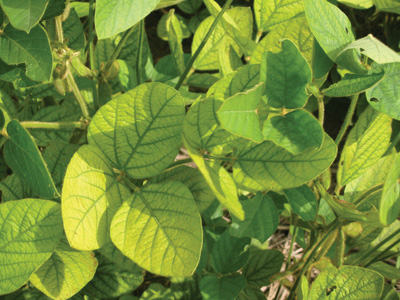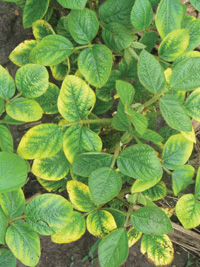
Features
Agronomy
Fertility and Nutrients
Mitigating nutrient deficiencies
Now that prices of key nutrients like phosphorus and potash have come down, the 2010 growing season may be the year that farmers can get their fertilizer plans back on track.
August 13, 2010 By Blair Andrews
Now that prices of key nutrients like phosphorus and potash have come down, the 2010 growing season may be the year that farmers can get their fertilizer plans back on track. In the face of soaring input costs during the last few years, many farmers chose to slash their fertilizer use. Combined with higher crop yields, the decision to curb fertilizer applications has raised the issue of soil nutrient deficiencies.
 |
|
| Manganese deficiency is also a problem, and it is showing up in the same fields in successive years.
|
Although they have their suspicions, provincial crop specialists do not have sufficient data to show that Ontario’s soils are suffering from a lack of nutrients. But Greg Stewart, corn specialist with the Ontario Ministry of Agriculture, Food and Rural Affairs (OMAFRA), is hearing more about lower test levels in discussions on the subject with farmers and agronomists. “It’s difficult to put a scientific number to it, but when I ask for a show of hands at events, asking who has nutrient levels that are medium or lower, I get some fairly aggressive responses from soil test lab people and professional agronomists who are seeing a fair bit of sagging soil test numbers on potassium,” explains Stewart. He adds that the cash croppers who do not have access to manure also are seeing lower test levels.
With relatively higher corn yields during the last few years, Stewart says it is obvious that potassium and phosphorous levels are being reduced at a faster rate than what Ontario farmers have been accustomed to in the past. Moreover, he notes that soybean-dominated rotations are particularly susceptible to lower potassium scores, as soybeans remove about twice the potash of grain corn. “Add that to relatively high potash prices and there are some fairly noticeable instances of phosphorus and potassium levels that are moderate or slipping.”
Horst Bohner, OMAFRA’s soybean specialist, also has seen lower soil fertility numbers. Echoing Stewart’s comments, he is not yet drawing any specific conclusions about nutrient deficiencies. “It makes a lot of sense when you think about crop removal and the amount of P and K going on. There’s just deficiency in terms of the amount of nutrients going on versus what’s coming off, and economics are a big driver, of course. I think it’s true, but I sure wouldn’t want to defend a PhD with the data we have so far.”
Pat Lynch, former head agronomist at Cargill AgHorizons, has crunched the numbers to show what he says is a phenomenal change in phosphorus and potassium use/additions in the soils across Ontario. Lynch compared the average corn and soybean yields for 2000 to 2004 with the average yields of the next five years. According to Lynch, the average corn yield has increased 29 bushels per acre and the average soybean yield is up by about seven bushels per acre. “When you take a look at the removal of phosphate and potash in the last five years compared with the previous five years, just due to the increase in yields, we have removed approximately 200,000 tonnes more phosphorus and potash than the previous five years just due to yield increases over that five-year period. And this was during a period that growers were reducing their normal phosphorus and potassium application rates.”
Lynch says removing nutrients through higher yields and then not replacing them with adequate fertilizer applications is producing an undesirable effect, which he describes as mining the soil. “At some point, you have to put what you take out of the soil back into the bank. You cannot keep depleting the soil forever.”
Impacts on other soil nutrients
Aside from potassium and phosphorus, Lynch is seeing more fields showing manganese deficiency. This nutrient is deficient every year in the same fields. But because it must be sprayed on, growers are reluctant to address it. He also notes that some fields may even benefit from nitrogen applications. These are fields that have grown a lot of soybeans. He states that he would not expect yield increases with nitrogen on really good soil where a good rotation is practised. Lynch acknowledges that, given the crop’s ability to fix nitrogen from the air, applying the nutrient to soybeans is a tough sell.
 |
|
| As growers cut their inputs, there is a greater tendency to see impacts such as potassium deficiency in soybeans. Photos courtesy of Horst Bohner, OMAFRA. |
Bohner adds that one has to be cautious when discussing nitrogen recommendations for soybeans. “Nitrogen in soybeans is a no-win situation,” he says. “Hundreds of trials have been conducted around the world, including in Ontario, and there is no economic return to applying nitrogen fertilizer for soybeans. The beans look greener for a short time after application, but do not yield more. I conducted five trials (in 2009) with nitrogen fertilizer and not one showed an economic response.”
In making his case for the nitrogen-on-beans recommendation, Lynch says that a nitrogen application can be beneficial during conditions when the crop has a difficult time getting started, notably in cold and wet soils. “We think of soybeans being nitrogen-producing and they don’t need any. But I think that in many years, in many fields, those bacteria are not getting going soon enough to get early nitrogen in those soybean plants,” says Lynch. “So I think we should be taking a look at 10 to 30 pounds of nitrogen with soybeans to get them started.”
Lynch adds that he is not suggesting that growers put 100 pounds of nitrogen on every acre. But he encourages farmers to see for themselves if it will pay to put 20 to 30 pounds on five or 10 acres. He also comments that the recent decrease in nitrogen prices means that growers should be using more nitrogen on corn than they did in 2009. Using the nitrogen calculator as a guide these levels are 20 to 30 lbs/ac more in 2010 than what the nitrogen calculator indicated for 2009.
Although fertilizer prices have come down, evaluating the input budget will not be an easy task. Greg Stewart notes that the potential of lower commodity prices could make the decision more difficult, saying that farmers have seen higher corn yields since about 2005 without investing much in fertilizer. For Stewart, the key issue is managing around the medium to low soil test levels. “With corn, there’s a fairly reasonable chance that if your soil tests have slid, you can probably make up that difference with starter fertilizers. It’s a different story for soybeans.”
When talking about boosting soybean yields, Horst Bohner says higher levels of potassium and phosphorus are required for the crop to attain yields in the 60 to 70 bushel per acre range. He explains that in various trials, he has noticed that higher yielding fields have high levels of P and K. “As a general statement, when I look at the trials we have completed on other subjects, like seed treatments, there’s definitely a trend that higher testing sites yield more. There’s no doubt in my mind that you need significant levels of P and K, if you are going to aim for those top yields. It’s rare to get 60 to 70 bushels in a low-testing field.”
Bohner says soil tests will give farmers a good indication if the nutrients in their soil are being depleted and if they’ll get a response from the fertilizer application. If growers have conducted soil tests every two to three years, he suggests that they graph the results across a 10-year period to see if their nutrient levels are on target.
As for his recommendations for the planning process, Pat Lynch encourages more farmers to set aside part of their budgets for fertilizer. He also advises growers to evaluate their budget with the help of a certified crop advisor. “Instead of shopping around for the best fertilizer prices, they should be sitting down to figure how to best spend their fertilizer dollars. And it could be that this farm is going to get 300 pounds of this blend, that farm is going to get 200 and another farm gets nothing or a starter fertilizer,” says Lynch. “We have too many people looking for a one-size-fits-all fertilizer recommendation, and it doesn’t work.”